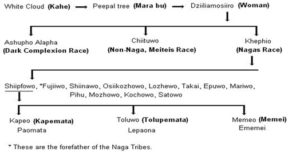Oral tradition, the source of all folklore is now being celebrated as the chronicle of human history by providing evidence to the origin of people and their subsequent migrations.
The Nagas are a group of Mongoloid communities speaking Tibeto-Burman languages who inhabit a mountainous country between the Brahmaputra plains in India and the hill ranges to the west of the Chindwin Valley in Upper Myanmar. Unwritten, unrecorded oral traditions, such as folktales, folksongs, wise sayings, and proverbs are the primary sources of their legends.
The customs, beliefs, values, and opinions of the Naga society have been handed down from their ancestors to posterity by word of mouth or by practice since the earliest times. Children are taught about survival, endurance, and respect for nature and all mankind through stories and legends from infancy. Storytelling and folktales have been an integral part of Naga society. However, these oral narratives have been rendered into written form only recently. By documenting and recording folklore, social scientists are hoping to preserve pieces of the traditional and oral cultures of some of the tribes and sects being pushed to India’s margins.
The Mao Naga tribe inhabits the northern region of Manipur. Mao is a Manipur name which was also adopted by the British. Today, the more accepted view and opinion of the term “Mao” is from the Maram Naga tribe, akin to the Mao’s. The origin of the Mao Nagas is very obscure, and there is no written document of their past. The history and customs are preserved in their memories, and handed down from one generation to another only through oral narration.
As is typically the case with oral tales, the Mao story about the origin of Man leaves a lot of things unexplained. For instance, the story does not reveal how the first woman came into existence. As the earth represents the divine mother, symbolising the reproductive power of nature, it is taken for granted that the first woman is already there.
The myth says that all life forms originated from the first Mother, with the process of creation or conception initiated by an act of union with the clouds. Logically, therefore, ‘Cloud People’ should mean the whole of mankind. However, only the guardians of this legend, known as Maos, or Ememei in their own language, can be called the ‘Cloud People. Although the story is not widely shared by other Naga tribes (it is only prevalent among the neighbouring Angami and Chakesang Nagas), it forms a centre piece of an assortment of myths, which taken together tell the story of origin of the Nagas at Makhel. This tradition is reinforced by a wide range of relics and monuments at and around Makhel, and forms the foundation for the identity of the Maos as well as the Nagas.
In an alternate narrative (The original story can be read here), it is told that the white clouds came and enveloped Dziiliamosiiro and she conceived and bore three sons namely –
Ashiipfo Alapha, known as the forefather of the dark complexioned people, the Aryan and Dravidian races (Kolamei pfope),
Chiituwo, the forefather of the Non-Naga Meitei race (Mikrumei pfope), and
Khephio, the forefather of the Naga race (Nagamei pfope).
The myth goes on to say that Ashiipfo Alapha’s descendants settled down in the dark jungle (Ive katei) on the west (kola po). The descendants of Chiituwo (Meities) settled in the south valley (Mikrii po). The generations of Khephio (Naga race) spread and settled in the hills of northeast India and western Myanmar.

There is another tale about the origin and migration of the Mao Naga, which seems more recent. In this myth, the forefathers of the Nagas arrived from China. The ancestors are said to have fled when an autocratic Chinese emperor forcibly ordered his subjects to help in constructing the Great Wall of China. The ancestors quietly escaped and began walking upstream along the river Kriiborii, a tributary of Chindwin River in Myanmar, for a long time and finally reached the source of the river, hidden from the emperor and his soldiers. They decided to settle down there and named the place “Makhrefii.”(Makhre – secret, fii- place).
Mythology reflects the socio-economic, cultural and historical conditions of the community or society. Creation of myth is creation of meaning, and there can be many levels of meanings.
The above myth represents evolution rather than the creation. Tiger and Man represent the animal kingdom and Spirit represents the supernatural realm. The Myth tells us that all are related, since they are born of a common mother. Participating in the competition is quite natural as they are brothers.
In attempting to decipher the meaning of the myth, the question of truth and falsity does not arise. Tiger wanting to eat the mother after her death is perhaps the reflection of wanting to take her power and authority.
The woman represents reproductive energy. Her name signifying pure water, being fertilized by a cluster of clouds is perhaps a metaphor of the union between the sky-father and the receptive earth mother, from which all things have originated.
References
1. The Myths of Naga Origin By R.B. Thohe Pou
2. http://en.wikipedia.org/wiki/Mao_Naga
3. The Mao Naga Tribe of Manipur: A Demographic Anthropological Study By Lorho Mary Maheo
4. The origin of Tiger, Spirit and Humankind: A Mao Naga Myth by Dr. X.P. Mao
5. THE ANGAMI NAGAS With Some Notes on Neighbouring Tribes J. P. Hutton
6. Folktales of India, edited by Brenda E. F. Beck, Peter J. Claus, Praphulladatta Goswami, Jawaharlal Handoo
7. http://www.iwgia.org/iwgia_files_publications_files/naga
8. The Kingship System of the Mao Naga by Chachei
9. TRADITION AND TRANSITION OF MAO NAGA: A STUDY ON THE ROLE OF GOVERNMENT by Komuha Jajuo and Tarun Bikash Sukai
10. Various oral narratives, songs, lectures and seminar proceedings